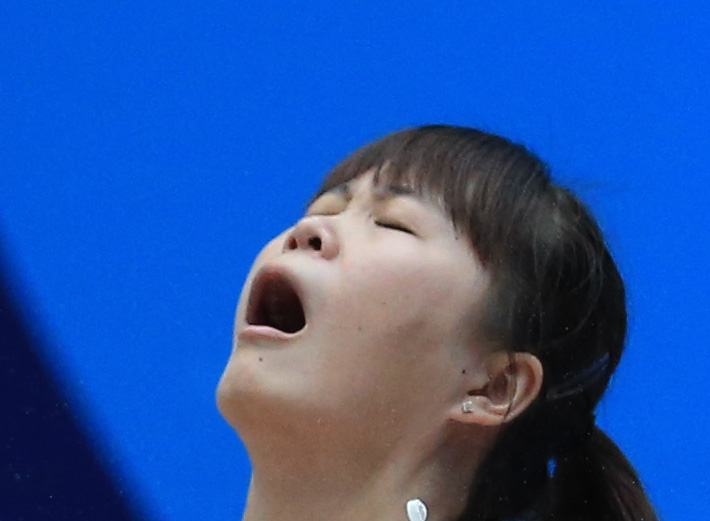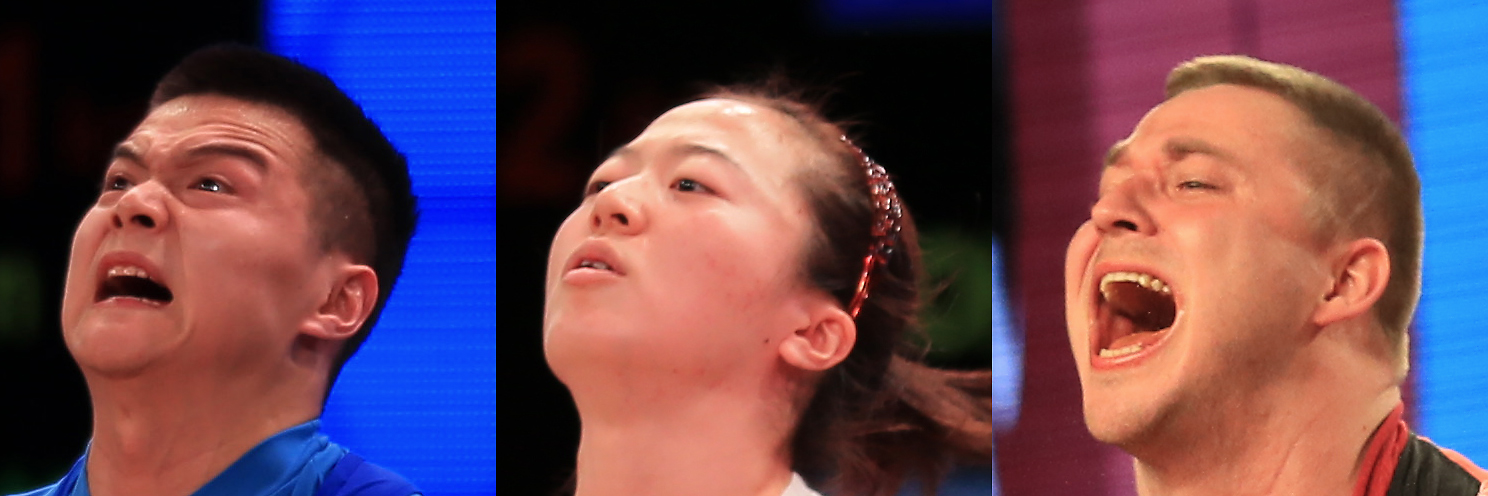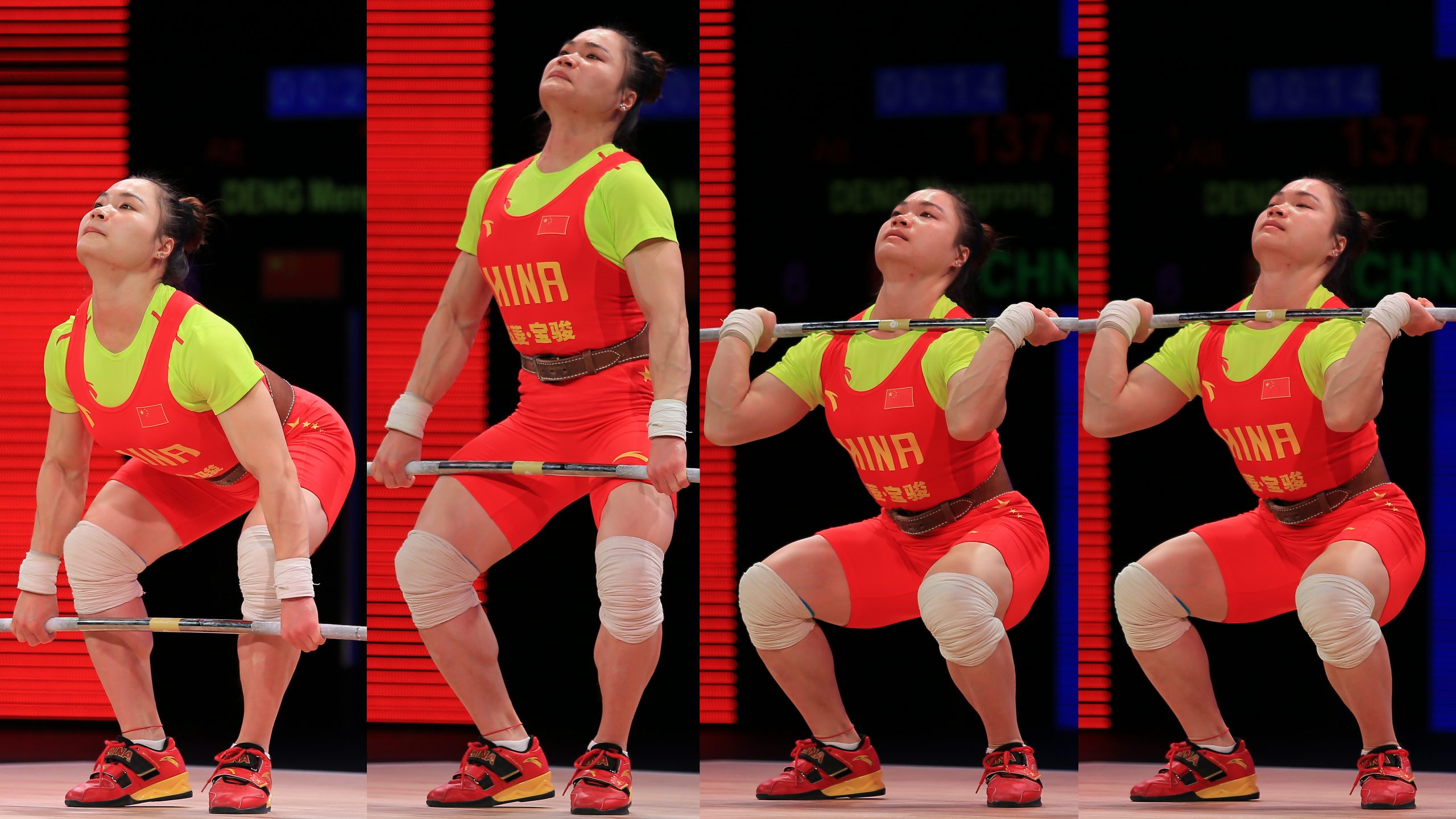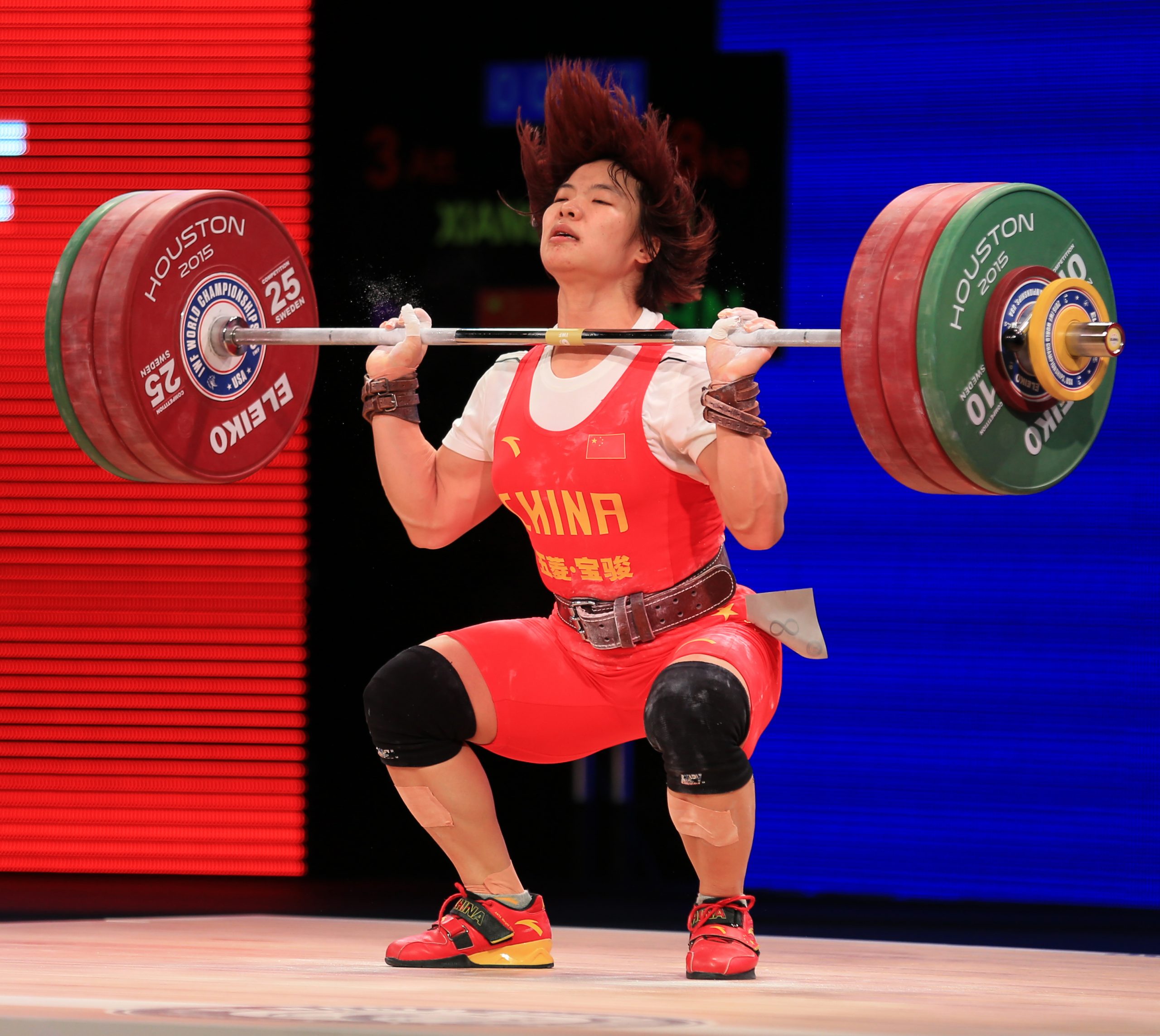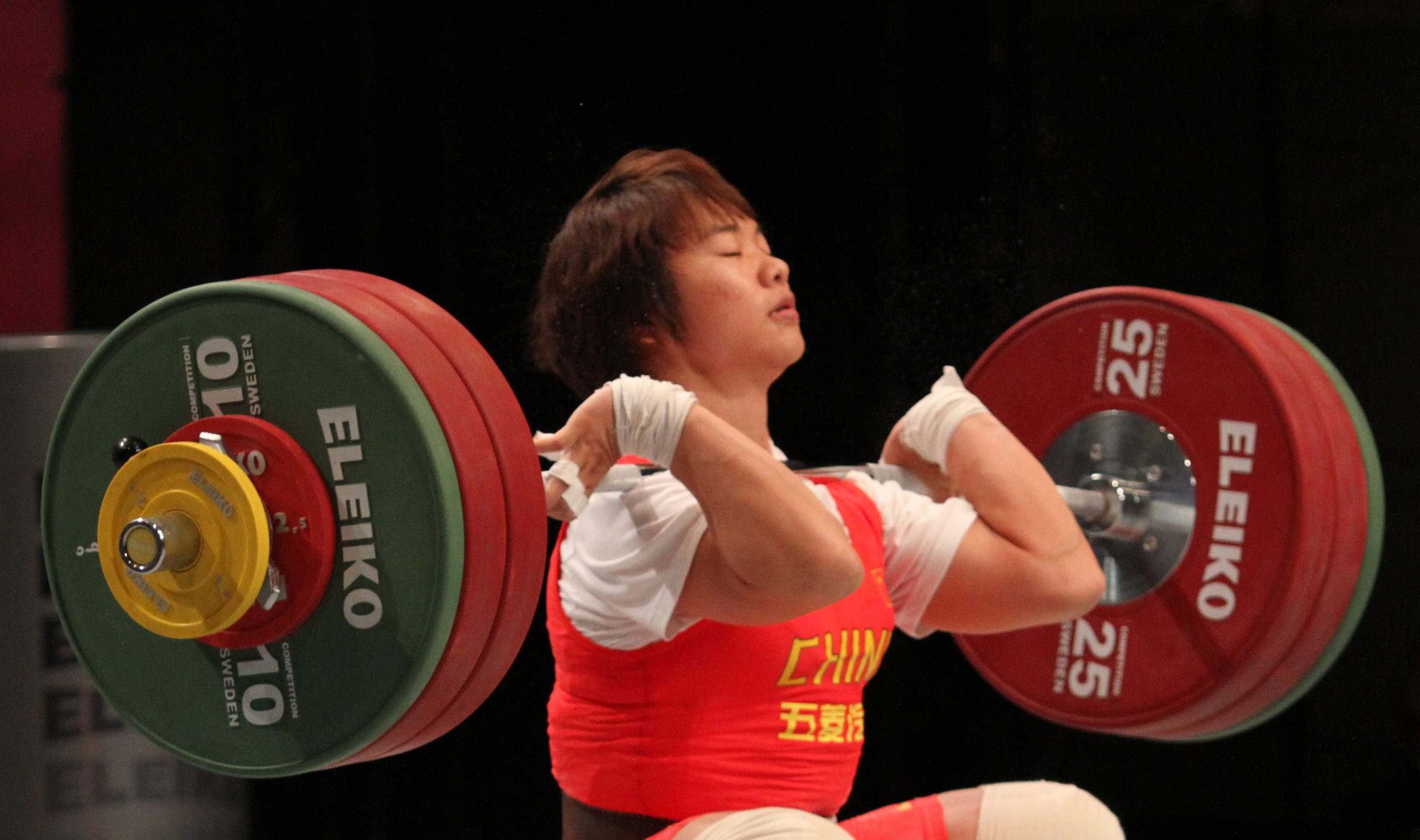Expression of Strength in Weightlifting
Andrew Charniga
Sportivnypress.com
“The forces produced by muscles in weightlifting does not take into account the sum of the power of the muscular contraction minus the resistance of the antagonist muscles. In theory less resistance of muscle antagonists would mean less force required to perform the exercise.” L.N. Sokolov, 1973
Figure 1. Contrasting {male/female/male} ‘Expressions’ of Strength {Straining}. Charniga photos
Gender Differences in ‘Expressing’ Strength and a Strong – Woman ‘Sleeping’
Strength for all practical purposes is synonymous with masculinity. Males have the obvious advantages over females of larger muscle mass, larger bones and tendons; ten times serum testosterone levels, and so forth. The facial expression of the strongman in action is most often associated with a three A’s of masculinity: anger; aggressiveness; assertiveness.
An expressed aggressiveness, especially a grimace, on the face of someone straining to lift a weight, for instance, is an enduring image; reflecting in psychological terms a masculine exclusivity of human strength.
“Aggression is part and parcel of what distinguishes male from female” (Colette Dowling, 2000).
Consequently, facial expressions most associated with weightlifters in the act of lifting, or other strength athletes for that matter, most often mirror the three A’s. However, just how a strong woman could fit into this stereotype; as much a physiological as psychological phenomenon; is an ambiguity of nature. Assertiveness and aggressiveness are qualities not closely connected with femininity. Granted strength has to come from within; but, an angry grimace during muscular effort need not be requisite.
There is little if anything in the special literature about gender differences in facial expressions connected with muscular strain. Research of gender differences in facial expression are usually connected with emotions and/or identifying gender from facial expression (Hess, 2009). However, there is a dearth, if anything on this topic, associated with gender differences in facial expression in a sport of maximum strain like weightlifting.
That being said, facial expression can be a window into the physiology of muscular tension. Muscular strain is usually accompanied with a grimace of varying intensity. It is common knowledge mechanical advantage varies throughout the performance of the weightlifting exercises with alterations in inertia and amplitude of movement; likewise the relative contribution of elastic recoil from tendons, fascia and ligaments.
The relaxed expression a world class sprinter straining to run at maximum speed is considered an outward reflection of the athlete’s optimization of internal mechanics (Verkhoshansky, 1977). However, given the specifics of sprinting, a relaxed facial expression is in effect an active, not a reactive phenomenon. That is to say, an integral part of the high class sprinter’s technique is to relax all unnecessary tension, facial muscles inclusive, to achieve optimum muscular tension and maximize inter-muscular coordination.
Gender differences of facial expression among weightlifters; and, how it might relate to possible differences in the approach to raising heavy barbells does not appear to have received any attention.
A fixed expression spanning exercises of such brevity as the snatch and the clean and the jerk is to be expected. Breath holding and straining go hand in hand. Holding the breath is a reaction to straining. Breath holding increases intra – abdominal pressure which supports the spine. At the same time, a reactive cessation of breathing facilitates the power of muscular contraction through neuro – logical mechanisms (Zatsiorsky, 1995, and others).
So, breath holding as lifting begins up until a point in the exercises where tension can be maintained without this facilitation; would seem inconsistent with multiple alterations in facial expression.
Facial expression during weightlifting exercises, unlike the active effort to relax facial muscles of the sprinter should be considered a reaction to the magnitude of the muscular strain. That being said, multiple alterations of expression, however subtle, over a fraction of a second as has been observed in super elite and elite female weightlifters; is a rather peculiar phenomenon. This phenomenon is all the more singular when these alterations of expression appear to be a reaction to changes in mechanical advantage, inertia of the barbell, and so forth.
“..women who show angry expressions are identified more slowly as women, and a person who looks angry is more likely considered a man”. Hess, 2009
Figure 2. A counter – Intuitive ‘expression’ of straining on the face of a super elite female lifting a maximum weight. Charniga photo
Some discrete, rapid alterations in the facial expression of the female weightlifter
Evidence from high speed still photos and observations of female weightlifters in competition and training has shown the facial expression of many elite and super elite female weightlifters can transform in rapid discrete shifts. These alterations of expression just happen to coincide with the variable conditions of mechanical advantage of the weightlifting exercises. The alterations of facial expression can only be reactive; conceivably an individual optimization of the female weightlifter’s physiology to lift a maximum weight.
Discrete alterations in facial expression, in all probability, mirror the female lifter’s intrinsic abilities to optimize tension of muscles, i.e., to eliminate unnecessary tension for effective rapid switching the disposition of the body during the weightlifting exercises.
The following are some of these rapid, discrete alterations in facial expression observed over the course of fractions of a second in the weightlifting exercises:
/ a relaxed expression at instant of barbell separation up to about knee level;
/ an expression of strain at the beginning of the final acceleration of the pull (barbell above knees);
/ a relaxed/placid expression as the recovery from the clean begins;
/ a relaxed expression {as if sleeping}, with eyes closing reflexively; as the lifter struggles through the most difficult part of the recovery of the clean (knee angles of 90 – 105°)
Figure 3. Alterations of facial expression of world champion female lifter during the clean and jerk. From left to right: relaxed during the preliminary acceleration; switching to strain in the final acceleration; relaxed/placid expression during the recovery of the clean and enhanced relaxation with eyes briefly closing at the most difficult portion of the recovery (a knee angle of 90 – 105°). Charniga photos.
The photos in figure 3 reveal four discrete, but nonetheless distinct alterations in facial expression of a world champion at four specific junctures of the clean and jerk exercise.
The first part of the pull is arguably the most difficult. The weightlifter has to overcome the barbell’s resting inertia and at the same time aggressively accelerate it. The weightlifter generates a force at barbell separation in the range of 140 – 160% of the weight of the barbell. Consequently, the relaxed facial expression of the super elite female pictured belies the magnitude of the requisite exertion.
Various researchers, Garhammer, Oleshko, Gougalis and others, recorded a slower speed of separation and preliminary acceleration of the barbell in both snatch and clean for the female weightlifter; in comparison with male lifters. However, “… in the final acceleration and the maximum speed of lifting, it tended to be larger for females”. {Oleshko, 2010). A low tech means of coming to the same conclusion is for the coach to ask a female lifter to go faster at the beginning of the lifting, and, meet this response, “I’m going as fast as I can”.
Generally, this gender difference in speed of producing power is thought to indicate females have a slower electro – mechanical delay, i.e., the time span between the decision to contract muscles and onset of tension.
The mechanical advantage of the pulling phases of the snatch and the clean change as the barbell passes the knees. The support reaction drops to 70-90% as the knees stop straightening before re – bending under the bar. As the weightlifter straightens the legs and trunk simultaneously the support reaction rises to 150 – 180% (Zhekov, 1976) of the weight of the barbell. The barbell has inertia and the lifter is able to ‘re – introduce’ the muscles which straighten the lower extremities and take advantage of the fast stretching of tendons (especially the Achilles tendon) as the knees are shifted under the weight, i.e., the conditions are mechanically more favorable.
The facial expression of the super elite and elite female lifters’ can transform rapidly from one of relaxation to a strained grimace and vice versa; in response to the change in the biomechanics of the exercises; where conditions for muscular effort are facilitated by storage and release of elastic energy, inertia, and so forth.
So, we have two facial expressions (reactions of focused strain) for the two main phases of the pull which one would expect to be flip flopped. A relaxed face in response to the more difficult conditions of raising the weight from the floor and a grimace in response to the mechanically favorable conditions of the final acceleration.
An efficient, rapid drop under the barbell in the snatch, the clean and the jerk depends to a great extent on the ability to switch from tensing to relaxing muscles. At the instant of switching from pulling to dropping, many super elite and elite female lifters change from an expression of straining to one of relaxation. The switch occurs in a very small fraction of a second; frequently, with eyes closed. In all probability, this a individual technique optimization to release unnecessary muscle tension in order drop fast and to absorb the elastic energy of the descending body and the oscillating barbell.
The ability to instantaneous switch muscular effort from tension to relaxation cannot be underestimated. Even a slow switch to muscle relaxation during these switching phases of the lifts is evidence of poor coordination. (Matveyev, 1977)
/ a relaxed expression, frequently with eyes closed as the lifter begins to receive the barbell at the chest in the clean;
Figure 4. Super elite female lifter descending under the barbell with an eyes – closed – -relaxed expression. Charniga photo
/ a relaxed expression with eyes closed as the lifter receives the full weight of the barbell in the deep squat of the clean;
Figure 5. World champion female lifter seemingly asleep as 148 kg barbell recoils in the low squat position of the clean. Charniga photo.
The ‘sleeping’ female weightlifter receiving the full weight of the barbell in the low squat in figure 5 is a unique ‘expression’ of muscular strain, i.e., an ambiguity of nature. Conceivably, the lifter reacts to the elastic deformation of the barbell and the stretching of muscles, tendons, ligaments. The relaxation of unnecessary muscle tension probably enhances the absorption of strain energy in tendons and ligaments; the release of this energy when she begins to stand, significantly reduces the requisite effort.
“…..elastic energy can be released from a spring like element much more rapidly than a muscle can shorten while it generates significant force”. A. Biewener, 2015
/ a relaxed expression at the beginning of the descent under the barbell, frequently with eyes reflexively closed;
Figures 6 & 7. Super elite female lifter switching from lifting up to descending under world record weight with subtle changes of expression including eyes closed. From left to right (figures 6 &7) the frames are separated by 0.083 seconds. The lifter’s expression transforms discretely four times (eyes open straining, eyes closed less strain, eyes beginning to open a little less strain, eyes open relaxed) over a span of approximately 0.249 sec., i.e., from tension to relaxation. The facial transformations coincide with the switching of the phases of pulling up to dropping down. Charniga photos.
Conclusions
The rapid transformations of facial expression of the super elite and the elite female weightlifters covered here are by no means comprehensive. However, a unique feature of these transformations of expression is they most frequently coincide with junctures in the exercises when the mechanical advantage changes. The female face expresses the change in mechanics relative to the variations in demand from the body: strain with the need to generate more energy; and, relaxation with the opportunity to absorb elastic energy.
Muscular effort is usually quantified in terms of physics: power, force against the ground. Technical proficiency in weightlifting is likewise expressed in terms of physics: bar trajectory, height of lifting, barbell speed and so forth. In theory, less muscle force is required to perform some exercise if muscles which are not actively contracting to generate power offer minimal resistance to the muscles which are. However, this reflexive ability to switch to an optimum relaxation of muscles to reduce resistance of movements in sport exercises is not readily quantifiable.
The super elite female weightlifter reflexively ‘dials down’ unnecessary resistance from tension in antagonist muscles; excessive tension in which can impede movement efficiency. This in its turn, enhances the efficacy of the agonists, i.e., the muscles generating the propulsive energy.
The rapid alterations in the facial expression of the super elite and elite female weightlifter; which just so happen to coincide with the changing mechanical advantages of the weightlifting exercises; conceivably manifest a high speed biological switch dialing down muscle tension to an optimum state, and, vice versa. A ‘relaxed’ strong woman, with facial expression as if ‘sleeping’ in the process of raising a maximum weight, articulates an individual optimization of the female body’s potential.
References:
1/ Hess, U., et al, “Face gender and emotion expression: Are angry women more like men?”, Journal of Vision (2009) 9(12):19, 1-8 “
2/ Verkhoshansky, Y.V., Fundamentals of Special Strength Training in Sport, Sportivny Press, Livonia, Michigan 48152
3/ Garhammer, J., Personal communication
4/ Oleshko, V., “Characteristics of the Movement of the Athlete/ Barbell System for Athletes of Different Sex”, Olimp 1-2:30-33:2010. Translated by Andrew Charniga, Jr. www.sportivnypress.
5/ Sokolov, L.N, “The Significance of Speed in Weightlifting and Methods to Develop it”. www.sportivnypress.com
6/ Zatsiorsky, V. M., Science and Practice of Strength Training, Human Kinetics, Champaign, IL. 1995
